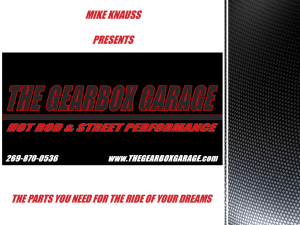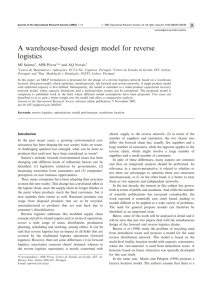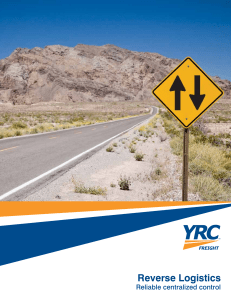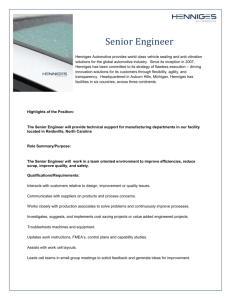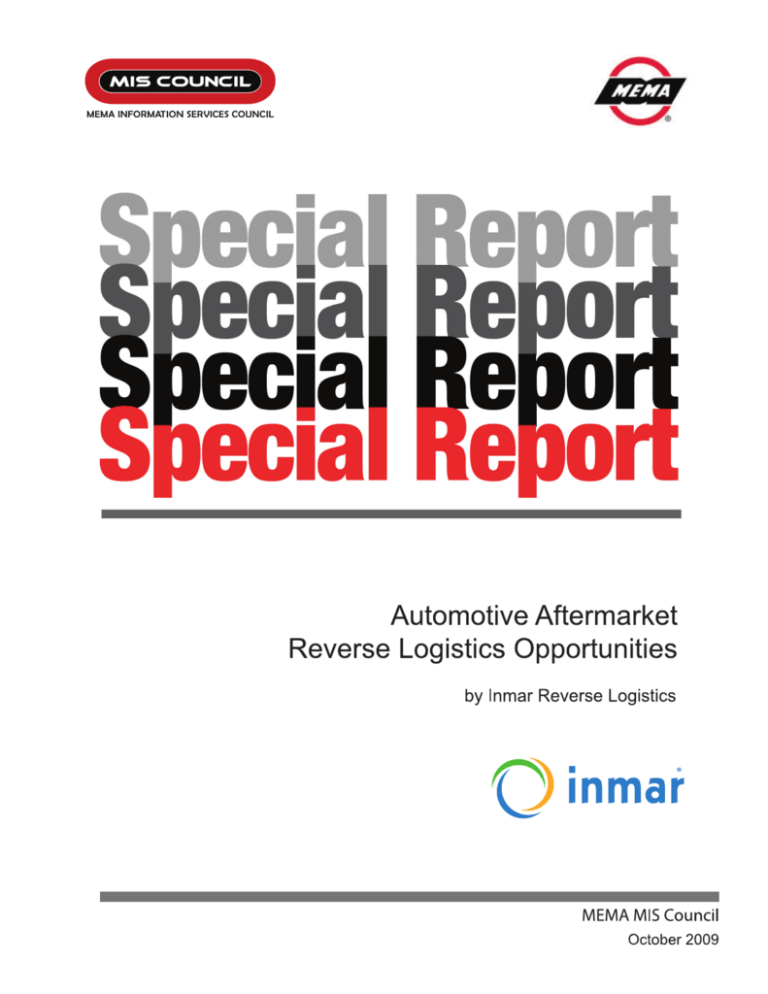
CONTENTS
01 Executive Summary
02 Challenges in the Automotive Aftermarket
Reverse Supply Chain
03 The Physical Flows
05 The Financial Flows
06 Information Flows
07 Successes in Other Industries
09 Returns as a Percentage
of Sales Reduction
10 Increased Level of Validation
11 Cycle Time Reduction
12 Summary
15 References and End Notes
16 About the MIS Council
16 About MEMA
16 About Inmar
16Contacts
Executive Summary
The economy continues to put pressure on many industries and the automotive
aftermarket industry is no exception. Faced with challenges that include cost
containment, anti-counterfeiting, and inventory management, the industry continues
to seek ways to streamline operations, cut costs and improve profitability and
at the same time apply green sustainability practices.
While important opportunities to achieve these goals exist within the reverse
supply chain, they are most often overlooked. “Reverse logistics is especially
critical to the aftermarket. Transporting, handling, and returning used products
present significant challenges, as well as potential profitability, for distributors.”1
The opportunity for potential profitability actually is not limited to distributors,
however; manufacturers also can experience significant gains by implementing
a reverse logistics program. With return rates that range from 5 percent to 25
percent, just a 1 percentage point reduction can mean significant savings to
a company’s bottom line.
This two-part paper provides information that will help you assess reverse logistics
opportunities within your organization.
Part I: Identifies known challenges within the physical, financial, and information
automotive aftermarket reverse supply chain flows.
Part II: Provides benchmarking information that includes results from a survey
conducted by the Automotive Aftermarket Suppliers Association (AASA) in 2009
and case study success stories from industries with mature reverse logistics programs.
Application of the information to your specific business objectives provides
a framework for building a program or enhancing an existing returns program for
improved profitability and sustainability.
© 2009 Inmar, Inc. CONFIDENTIAL
Not to be reproduced or distributed without written permission from Inmar
01
Challenges in the Automotive
Aftermarket Reverse Supply Chain
The automotive aftermarket is not the simplest of industries. With an explosion of SKUs and a multi-step supply
chain, the physical, financial and information flows within this supply chain are extremely complex and intense.
This complexity is compounded when considering the reverse supply chain.
In a recent AASA survey, members were asked their company’s overall return rate as a percentage of sales.
The average return rate was 5.9 percent based on responses from 40 manufacturer members. This number is
somewhat lower than another published report of 9.7 percent from a study conducted by Counterman Magazine in which 90 percent of the respondents were jobbers.1 Both numbers were significantly lower than the 25
percent quoted in previous years. Based on these return rates, the value of returns in the automotive aftermarket
conservatively totals somewhere between $3.5 billion and $5.7 billion. A number of factors contribute to returns:
•Poor information flow
•Multiple networks that poorly interface with one another
•Different numbering schemes for the same replacement parts
•Data entry order errors
•Incorrect shipments
•Mis-diagnosis
•Over ordering
•Warranty/Defective parts
To provide perspective from the viewpoint of jobbers, the study conducted by Counterman Magazine, indicated
that their reasons for returns were as follows:2
JOBBERS REASONS FOR RETURNS
02
© 2009 Inmar, Inc. CONFIDENTIAL
Not to be reproduced or distributed without written permission from Inmar
Challenges in the Automotive Aftermarket Reverse Supply Chain
Yet, when AASA members were asked to name their greatest challenge associated with returns, 31 percent cited
compliance/accountability/abuse, which includes not following return authorization details or returns policy,
getting customers to redeploy inventory within their system, or ruining new parts because of improper repair
procedures. Manufacturers expressed concern that a leading cause of returns is mis-diagnosis, which leads
to use of the wrong part. Rather than being placed back into inventory, that wrong part often becomes a return.
No trouble found (NTF) represents as much as 75 percent of returns for some manufacturers and is a huge sore
spot among all parties involved.
BIGGEST CHALLENGES WITH RETURNS
The Physical Flows
Two types of returns physically flow through the automotive industry’s reverse supply chain – Cores and
Warranty/Defectives. Cores are those used products that can potentially be restored to a useful life.
Warranty/Defectives are products that cannot be restored and typically are scrapped or harvested for parts.
AASA members indicated 25 percent of their returns are under warranty, which would indicate that 75 percent
of returns are cores.
To understand the opportunity, one must first understand the reverse supply chain network. With approximately
80,000 jobbers and 200,000 service centers, the automotive aftermarket is extremely complex.3 The complexity
increases because there is not a single, consistent flow of product.
AUTOMOTIVE AFTERMARKET REVERSE FLOW 1
Manufacturer
Wholesaler/Distributor
Jobber
Installer
Consumer
© 2009 Inmar, Inc. CONFIDENTIAL
Not to be reproduced or distributed without written permission from Inmar
03
Challenges in the Automotive Aftermarket Reverse Supply Chain
AUTOMOTIVE AFTERMARKET REVERSE FLOW 2
Manufacturer
Wholesaler/Distributor
Installer
Consumer
AUTOMOTIVE AFTERMARKET REVERSE FLOW 3
Manufacturer
Big Box Retailer
Consumer
Manufacturers may choose to physically handle returns in one or a combination of the following options:
•Have a Sales Representative Review Returns at the Wholesaler/Distributor Location
•Return to Manufacturer Distribution Center
•Ship to Third Party Processor Returns Center
•Do not Accept Physical Returns
According to the AASA survey, members process their returns at the following locations.
LOCATIONS FOR RETURNS PROCESSING
According to the 2008 Third Party Logistics Automotive Industry Findings report, automotive respondents
overwhelmingly agree that a “green” supply chain is becoming increasingly important. The automotive industry
has made some progress in this area by improving transportation efficiency through effective shipment
consolidation, routing and mode consolidation. The study also revealed that automotive respondents had not
significantly leveraged reverse logistics processes to recover otherwise wasted materials and provide effective
inventory management to reduce the need for small expedited shipments.3 This is where important opportunities
lie for companies to make reverse logistics a high priority in order to improve sustainability.4
04
© 2009 Inmar, Inc. CONFIDENTIAL
Not to be reproduced or distributed without written permission from Inmar
Challenges in the Automotive Aftermarket Reverse Supply Chain
A returns process that consolidates returns for shipment to a centralized location for processing and disposition
establishes a framework and foundation for recovering assets through remanufacturing, recycling, or refurbishing.
Numerous studies have confirmed that remanufacturing or “reman” is profitable for manufacturers.5 And, while
a primary obstacle to reman is the difficulty of obtaining cores from the core brokers and the collision shops
in order to put a reman program in place, a good reverse logistics network can remove that obstacle. A good
reverse logistics network has a positive impact on the decision to reman an aftermarket/service part.6
The remanufacturing of cores and the harvesting of parts for defectives are positive and profitable sustainability
programs to green the reverse supply chain.
The Financial Flows
The financial flow associated with returns involves the credits for core and warranty product returns. A returns
policy is the starting point that facilitates decision-making for credits. However, manufacturers struggle with their
customers’ policies that many times are viewed as “no questions asked” or “never say no” approaches.
At the same time, retailers, wholesalers/distributors and jobbers struggle to strike a balance between policies
that are too rigid or too lenient because return policies are seen as a competitive advantage for building
consumer and installer loyalty.
Manufacturers miss capturing important information when they do not take back returns but instead simply take
the deduction, resulting in no data available to push back on the return if necessary.
For those that accept returns in order to initiate credit, the returns processing time impacts the credit cycle time.
In the AASA survey, 41 percent of responding members indicated they experienced a processing backlog.
RETURN PROCESSING BACKLOG
When asked what their return-to-credit cycle time was for the returns process, the average was 42 days.
Thirty-two percent of the responding members indicated that the accounting/finance group was responsible for
applying the credit adjustment for returns, while 28 percent indicated sales/marketing was responsible for any
adjustments. Sales, however, tends to “let the adjustment go” if they fear that pursuing it could jeopardize
the relationship with their customer.
© 2009 Inmar, Inc. CONFIDENTIAL
Not to be reproduced or distributed without written permission from Inmar
05
Challenges in the Automotive Aftermarket Reverse Supply Chain
FUNCTION RESPONSIBILE FOR APPLYING RETURNS ADJUSTMENTS
As stated previously, those surveyed indicated that 25 percent of their company’s returns fall under warranty.
Seventy-seven percent responded that their company sytematically validates warranty claims and 85 percent
responded that they are able to track to the item level. This is good news from a warranty management
perspective. However, feedback shared in the survey raised the issue of warranty fraud and its relation to returns.
(Accenture reports that it finds that between 10 percent to 15 percent of of warranty-related payments are either
fraudulent or invalid claims.7) Fraud occurrs through a number of methods. Examples include:
•Handwritten invoices are submitted for the warranty claim creating suspicion when multiple identical claims
are submitted. Furthermore, the manufacturer has no way to verify that product was actually installed.
•Customer is told they need a new part. However, the new part is not installed, but the manufacturer is billed
as if it was defective
•Customer does not know that the product is under warranty; so, they pay for the product. The installer then
returns a warranty claim, basically double-dipping.
•Repair shops submit a “padded” estimate to insurance company and obtain approval for repair. Rather than
using new product, they install used product or straighten the damaged part. The new part is then returned
for credit.
These scenarios along with concern regarding an increase in counterfeit product begs for better processes that
enable increased controls and scrutiny.
Information Flows
Most everyone would agree that returns visibility improves inventory management, compliance monitoring, fraud
detection and reduces returns. This includes visibility to the warranties, return authorizations, customer reason for return
and physical return quantities. With visibility to the data, below are just a few examples of what can be accomplished.
•Inventory is better managed eliminating excessive scrap from over-buying.
•Customer compliance is monitored and returns are factored into customer’s P&L statement.
•Returns are reduced by identifying defective reasons.
Many companies are beginning to use dashboards to quickly identify and monitor against key performance indicators
(KPI) or to establish alerts or exception monitoring that enable quick action. Real time data for returns processing and
integration with other data is a reality in many industries today, providing them with a holistic detailed view of their
supply chain.
06
© 2009 Inmar, Inc. CONFIDENTIAL
Not to be reproduced or distributed without written permission from Inmar
Successes in Other Industries
According to an article by Larry Lapide, a Researcher at the MIT Center for Transportation & Logistics, every
industry has some good supply chains from which to learn. This is not about learning about a company’s
so-called “best practices.” Rather, it concerns learning from things done well as a matter of course in an industry,
not necessarily done for competitive differentiation. These practices are industry “competencies.”6
The data collected from the survey is a starting point for benchmarking analysis with other industries.
The following charts share the responses to the questions who has responsibility for returns and what return
benchmarks are established within the company.
FUNCTION RESPONSIBLE FOR RETURNS
Based on survey responses, it appears that automotive industry returns are the responsibility of each distribution
center. This approach is different from other industries such as grocery, drug, pharmaceutical, sporting goods
and footwear in which responsibility for returns is most often centralized within a corporate supply chain
function. The grocery industry by far is the most mature with respect to reverse logistic practices. In this industry,
a position and sometimes even an entire department have been created to focus solely on reverse logistics.
The organizations that have made reverse logistics a priority in terms of resources and top management support
have achieved reductions in their return rates as a percent of sales. The chart below illustrates the organization
of some of the most succesful companies.
© 2009 Inmar, Inc. CONFIDENTIAL
Not to be reproduced or distributed without written permission from Inmar
07
Successes in Other Industries
Best Practice
Example
Process Owner
Department
Entire
Business or
By Bus Unit
Full Time or # of People Executive
Part Time
Dedicated
Sponsorship Title
to RL
Client A D
irector
Distribution
Across Entire
Business
Full Time
1V
P Supply Chain
Client B
Senior Manager
Customer
Logistics
Across Entire
Business
Full Time
2D
irector Supply
Chain & Customer
Logistics
Client C D
irector, Returns
Management &
Remarketing
Across Entire
Business
Full Time
5V
P, Cross Channel
Operations
Client D D
irector
Quality
Across Entire
Business
Full Time
3V
P Quality
Assurance
Client E D
irector Reverse
Supply Chain
Across Entire
Business
Full Time
4
Senior VP Inventory
Management
The benchmarks shared by the survey respondents were consistent with the performance indicators in other
industries. Percent reduction in returns appears to be the universal measurement.
BENCHMARKS FOR RETURNS MANAGEMENT
The following three case studies share the stories of companies in other industries that have been successful
in achieving the benchmarks and performance indicators in the areas of:
•Percent Reduction in Returns
•Increased Level of Validation
•Reduction in Cycle Time
While these examples are by no means exhaustive, they demonstrate that there are a wide variety
of competencies across industries from which to learn.
08
© 2009 Inmar, Inc. CONFIDENTIAL
Not to be reproduced or distributed without written permission from Inmar
Successes in Other Industries
Returns as a Percentage of Sales Reduction
THE CHALLENGE
A leading producer of convenience foods experienced a damage rate for a particular product line of 0.8
percent of sales, as measured at the customer pick slots. The manufacturer engaged Inmar Reverse Logistics
as its third-party returns supplier to conduct failure analysis on returned product. Working with the manufacturer,
Inmar developed a plan to collect relevant data throughout the client’s supply chain, including at the customer
warehouse, retail stores and reclamation centers. The plan detailed what data were to be collected, the process
for collection and defined measurement standards. In this case, Inmar collected data for two years in order
to establish a baseline prior to the implementation of any significant changes. This approach became a key
component within the client’s Closed-Loop Returns Management System in which the goal was increased
profitability rather than simply to reduce unsaleables. Within this system, all departments are accountable
for reducing unsaleables.
THE SOLUTION OVERVIEW
During the two-year period, Inmar analysts evaluated product condition at various locations as called for
in the plan. Key analysis tools were developed that allowed the data to be sorted and analyzed in infinite
combinations to convert the data into actionable information. As data were converted into information and
knowledge, opportunities to put measurements in place in key areas were identified. A scorecard system was
implemented that measured and ranked manufacturing plants and distribution centers on an ongoing basis.
The scorecard showed the issues that were driving defects by measuring the ability to produce, build and
deliver defect free shipments to customers. As a result, all parties knew where to focus their improvement efforts.
Numerous causes of damage were identified and resolved. The causes ranged from adhesive failure to the use
of slip sheets, which were found to result in a 160 percent increase in damage.
THE RESULTS AND CLIENT BENEFITS
Implementation of Inmar Reverse Logistics study findings resulted in the 75 percent decrease in the damage rate
for this product line. Findings also resulted in improved process efficiencies, improved customer and consumer
satisfaction, and reduced costs for both the Inmar client and its customers.
© 2009 Inmar, Inc. CONFIDENTIAL
Not to be reproduced or distributed without written permission from Inmar
09
Successes in Other Industries
Increased Level of Validation
THE CHALLENGE
An industry-leading auto parts retailer handled returns in-house for more than 7,000 U.S. store locations.
Returns practices were inconsistent among its independent stores and 65 DCs. The company sought to outsource
returns management in order to gain the ability to invoice vendors and issue store credits, as well as more closely
monitor independent store returns practices. The company required a partner who could also manage Warranty
Validation. Additionally, outsourcing returns management would enable this retailer’s DCs to focus on forward
logistics—an objective common among a growing number of retailers and manufacturers.
THE SOLUTION OVERVIEW
Applying LEAN Principles, Inmar Reverse Logistics reengineered its facility process flow, which significantly
enhanced the efficiency of the company’s returns management function and positioned it to better accommodate
this client’s service needs. Client returns were centralized into two Inmar facilities. Store credits are now issued
daily via EDI and forwarded to the organization’s headquarters. Inmar provides monthly reporting on both
the vendor and store sides and conducts warranty as well as causal analysis.
THE RESULTS AND CLIENT BENEFITS
Redesign of its returns management process has enabled Inmar to improve service for this client by significantly
reducing cycle time for returns processing. Inmar has achieved a 40 percent improvement in daily capacity.
The client has visibility to store level returns and compliance through Inmar’s extensive reporting capabilities.
Clear and consistent management of warranty issues has improved vendor relationships, with automated
warranty reporting available for certain vendors. Finally, labor resources and DC space have been reallocated
to forward distribution activities.
10
© 2009 Inmar, Inc. CONFIDENTIAL
Not to be reproduced or distributed without written permission from Inmar
Successes in Other Industries
Cycle Time Reduction
THE CHALLENGE
A premier retailer with stores located throughout the U.S. and in Canada received store returns in its distribution
center. While items were scanned into the system at the store level, the processes for handling the returns and
determining disposition at the central Returns Facility were manual and inconsistent. Appropriate staffing levels
and resource allocation were difficult to maintain and manage due to fluctuations in returns volume, especially
those experienced during peak seasons. The resulting backlog slowed the company’s ability to recover returns
revenue from vendors, reconcile valuable store inventory, and distracted from forward distribution activities
(in terms of the labor and space required).
THE SOLUTION OVERVIEW
Client returns are now received and processed at a central Inmar facility. Store processed transfer information is
consolidated and transmitted each night in file format to the Inmar warehouse management system for immediate
reconciliation when Inmar physically processes each store’s returns. Transfer variance files, which are generated
as a result of this matching process, are sent nightly to the client, creating an electronic audit file. Inmar also
developed and automated the process to determine product disposition based upon the policies of the client
and its vendors. Additionally, product determined appropriate for “disposition” through the client’s outlet stores
is re-priced, bar coded and tagged, as well as defaced at the Inmar facility.
THE RESULTS AND CLIENT BENEFITS
The Inmar solution has tripled this client’s returns throughput and significantly increased its billable amount and
processing accuracy. Inmar also delivered a scalable solution for returns management that can accommodate
its growth plans and sizeable seasonal fluctuations in volume. The retailer’s entire backlog of returns was
processed within 30 days of implementation. And, lastly, with valuable labor and space free to focus on forward
distribution activities, this client considers itself “officially out of the returns business.”
© 2009 Inmar, Inc. CONFIDENTIAL
Not to be reproduced or distributed without written permission from Inmar
11
Summary
While the automotive aftermarket industry faces many challenges related to reverse logistics, there are even more
opportunities to implement new processes all the way to the shop that can help streamline operations, cut costs
and improve profitability and at the same time apply green sustainability practices. With new environmental
regulations and sustainability pressures, more companies are focusing on reverse logistics. Those that implement
sooner rather than later will have a competitive advantage.
Based on the results of the survey, many of the members are ready to take action. Fifty-nine percent of
the respondents indicated that returns are of high priority within their companies. Prioritization is the first step
to success.
PRIORITY OF RETURNS
If more back-up and support are needed to make the case internally, the following are some key quotes from
industry research professionals.
•According to Gartner, Inc., improperly handled returns reduce net profit by 35 percent. The solution to making
the process pay: Automate the reverse logistics process.8
•Managers strongly agree that effective returns management helps brand equity, environmentally responsible
activities enhance brand equity, and shorter cycle time helps bottom lines.9
•Things may get worse before they get better to the extent the aftermarket does not address the very real
challenges it faces in the areas of inventory management, reverse logistics, supply chain integration and
electronic cataloging.10
The 2008 Third Party Logistics Automotive Industry Findings reported that 73 percent of the automotive users
agree that 3PLs have had a positive impact on business process efficiencies for their forward business. With only
32 percent of Auto respondents indicating that they currently outsource Reverse Logistics11, there is an opportunity for an even greater positive impact on your business. By outsourcing your non-core business competency
of reverse logistics, your organization can shorten the learning curve as well as the speed toward streamlined
operations, reduced costs, improved profitability and a greener supply chain.
12
© 2009 Inmar, Inc. CONFIDENTIAL
Not to be reproduced or distributed without written permission from Inmar
References and End Notes
“Are Your Returns Really that High?” March 12, 2009. Counterman Magazine. 23 September 2009,
<http://counterman.com/Article/46270/are_your_returns_really_that_high.aspx>
1
“Are Your Returns Really that High?” March 12, 2009. Counterman Magazine. 23 September 2009,
<http://counterman.com/Article/46270/are_your_returns_really_that_high.aspx>
2
“IT for the Aftermarket .” December 2003. Automotive Design and Production. 20 September 2009,
<http://www.autofieldguide.com/issues/1203.html>
3
The State of Logistics Outsourcing 2008 Third Party Logistics Automotive Industry Findings.” 23 September
2009, <http://www.us.capgemini.com/DownloadLibrary/files/factsheets/Capgemini_3PL_study_Automotive_
FS0209.pdf>
4
”Remanufacturing for the Automotive Aftermarket-Strategic Factors: Literature Review and Future Research
Needs.” Ramesh Subramoniam, Donald Huisingh, Ratna Babu Chinnam. May 1, 2009. Journal of Cleaner
Production.
5
6
“Learning from others.” Larry Lapide. Supply Chain Management Review. January 1, 2008.
“Rethinking Warranty Management to Achieve High Performance and Differentiation.” R. Douglas Derrick.
Accenture Outlook Point of View. February 2004.
7
“Reverse Logistics, the Bearer of Good Fortune” Lee Norman. December 3, 2007. Reverse Logistics Association
News. 25 September 2009, <http://www.reverselogisticstrends.com/shownews.php?id=4978>
8
“Current Practices in Reverse Logistics: Three Case Studies .” Xiaoming Li, Ph.D., & Festus Olorunniwo, Ph.D.,
Department of Business Administration, Tennessee State University, May 4 - 7, 2007. POMS Annual Conference.
20 September 2009. <http://www.poms.org/conferences/poms2007/cdprogram/topics/full_length_papers_
files/007-0145.pdf>
9
Automotive Aftermarket B2bid Site Ceases Operation.” January 19, 2001. The Auto Channel. 25 September,
2009, <http://www.theautochannel.com/news/2001/01/19/013098.html>
10
The State of Logistics Outsourcing 2008 Third Party Logistics Automotive Iindustry Findings. 23 September
2009, <http://www.us.capgemini.com/DownloadLibrary/files/factsheets/Capgemini_3PL_study_Automotive_
FS0209.pdf>
11
© 2009 Inmar, Inc. CONFIDENTIAL
Not to be reproduced or distributed without written permission from Inmar
13
References and End Notes
About the MIS Council
The MEMA Information Services Council, a peer group of the Motor and Equipment Manufacturers Association
(MEMA), serves as a medium for industry interaction, education and idea exchange regarding matters
of common interest to information technology (IT) and e-commerce professionals in the automotive aftermarket
industry. It provides industry leadership and information through semi-annual conferences, committee activities,
monthly newsletters and IT education.
About MEMA
Suppliers manufacture the parts and technology used in the domestic production of millions of new cars
and trucks produced each year, and the aftermarket products necessary to repair and maintain more than 247
million vehicles on the road today. MEMA supports its members through its three affiliate associations, Automotive
Aftermarket Suppliers Association (AASA), Heavy Duty Manufacturers Association (HDMA), and Original
Equipment Suppliers Association (OESA). For more information on the motor vehicle parts supplier industry,
please visit www.mema.org.
About Inmar
Inmar operates collaborative commerce networks and makes them intelligent. Retail, healthcare, and
manufacturing clients choose Inmar’s networks to simplify and securely manage their complex transactions
with trading partners so they can focus on their core business. Founded in 1980, Inmar is headquartered in
Winston-Salem, North Carolina with more than 4,500 employees in the United States, Mexico and Canada.
Contacts
Chris Gardner
Vice President, Programs & Member Services, Member Satisfaction
Automotive Aftermarket Suppliers Association
919.406.8830
cgardner@mema.org
Sharon Joyner-Payne
Inmar VP Communications
336.631.7663
sharon.joyner-payne@inmar.com
www.inmar.com
14
© 2009 Inmar, Inc. CONFIDENTIAL
Not to be reproduced or distributed without written permission from Inmar
2601 Pilgrim Court
Winston-Salem, NC 27106
USA
www.inmar.com
855.815.2646
solutions@inmar.com
Copyright © October 2009, Inmar. All rights reserved.
No part of this book may be reproduced in any form without written permission
from Inmar. Inquiries regarding permission for use of the material contained in
this book should be addressed to:
Inmar
2601 Pilgrim Court
Winston-Salem, NC 27106
855.815.2646
solutions@inmar.com
Disclaimer: These documents do not constitute legal advice. Inmar advises all
reviewers to seek advice from legal counsel based on specific business needs.



